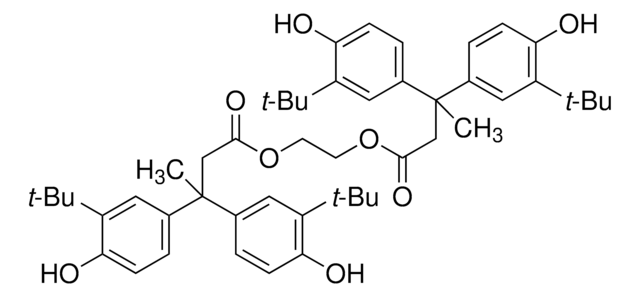O0140000
Plastic additive 20
European Pharmacopoeia (EP) Reference Standard
Sinônimo(s):
Oleamide, Oleamide R, cis-9,10-Octadecenoamide, cis-9-Octadecenamide, Oleic acid amide
About This Item
Produtos recomendados
grau
pharmaceutical primary standard
fabricante/nome comercial
EDQM
controle de medicamentos
regulated under CDSA - not available from Sigma-Aldrich Canada
aplicação(ões)
pharmaceutical (small molecule)
formato
neat
temperatura de armazenamento
2-8°C
cadeia de caracteres SMILES
CCCCCCCC\C=C/CCCCCCCC(N)=O
InChI
1S/C18H35NO/c1-2-3-4-5-6-7-8-9-10-11-12-13-14-15-16-17-18(19)20/h9-10H,2-8,11-17H2,1H3,(H2,19,20)/b10-9-
chave InChI
FATBGEAMYMYZAF-KTKRTIGZSA-N
Procurando produtos similares? Visita Guia de comparação de produtos
Descrição geral
Aplicação
Ações bioquímicas/fisiológicas
Embalagem
Outras notas
Frases de perigo
Declarações de precaução
Classificações de perigo
Aquatic Chronic 4
Código de classe de armazenamento
11 - Combustible Solids
Classe de risco de água (WGK)
WGK 1
Ponto de fulgor (°F)
404.6 °F - closed cup
Ponto de fulgor (°C)
207 °C - closed cup
Choose from one of the most recent versions:
Certificados de análise (COA)
Sorry, we don't have COAs for this product available online at this time.
If you need assistance, please contact Atendimento ao cliente
Já possui este produto?
Encontre a documentação dos produtos que você adquiriu recentemente na biblioteca de documentos.
Nossa equipe de cientistas tem experiência em todas as áreas de pesquisa, incluindo Life Sciences, ciência de materiais, síntese química, cromatografia, química analítica e muitas outras.
Entre em contato com a assistência técnica







